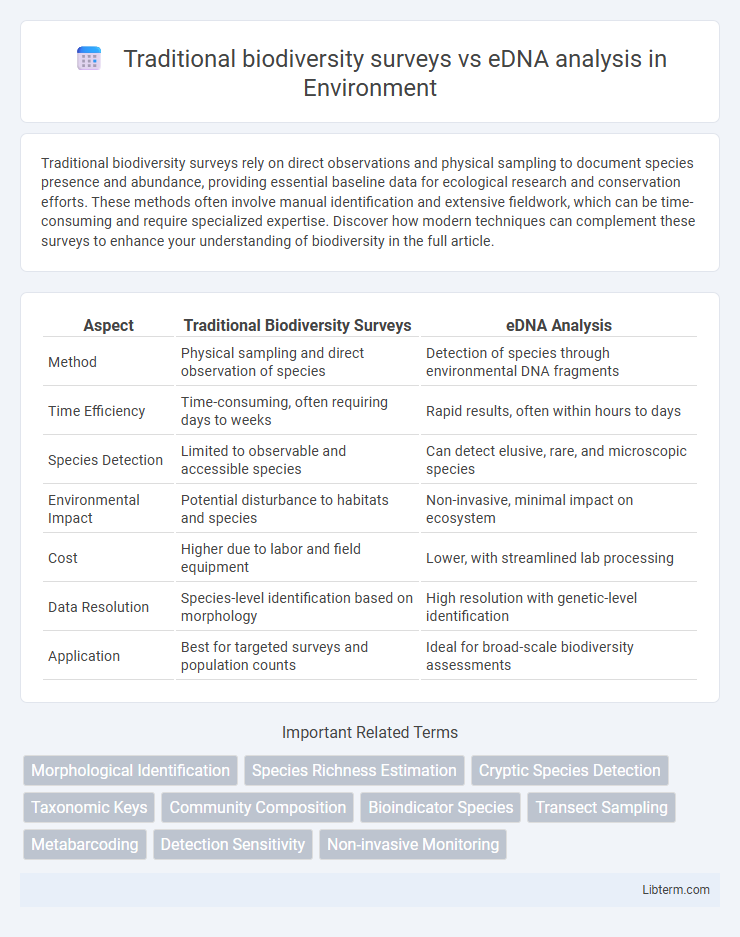Traditional biodiversity surveys rely on direct observations and physical sampling to document species presence and abundance, providing essential baseline data for ecological research and conservation efforts. These methods often involve manual identification and extensive fieldwork, which can be time-consuming and require specialized expertise. Discover how modern techniques can complement these surveys to enhance your understanding of biodiversity in the full article.
Table of Comparison
| Aspect | Traditional Biodiversity Surveys | eDNA Analysis |
|---|---|---|
| Method | Physical sampling and direct observation of species | Detection of species through environmental DNA fragments |
| Time Efficiency | Time-consuming, often requiring days to weeks | Rapid results, often within hours to days |
| Species Detection | Limited to observable and accessible species | Can detect elusive, rare, and microscopic species |
| Environmental Impact | Potential disturbance to habitats and species | Non-invasive, minimal impact on ecosystem |
| Cost | Higher due to labor and field equipment | Lower, with streamlined lab processing |
| Data Resolution | Species-level identification based on morphology | High resolution with genetic-level identification |
| Application | Best for targeted surveys and population counts | Ideal for broad-scale biodiversity assessments |
Introduction to Biodiversity Survey Methods
Traditional biodiversity surveys rely on direct observation, specimen collection, and visual identification, often requiring expert taxonomists and extensive fieldwork to assess species presence and abundance. eDNA analysis detects genetic material shed by organisms into the environment, offering a non-invasive, sensitive, and efficient alternative for monitoring aquatic and terrestrial biodiversity. Both methods provide complementary data, with traditional surveys capturing morphological traits and behavior, while eDNA enables detection of elusive or low-density species often missed by conventional techniques.
Basics of Traditional Biodiversity Surveys
Traditional biodiversity surveys involve direct observation, collection, and identification of species through methods such as transect walks, quadrat sampling, and netting. These methods provide detailed information on species abundance, behavior, and habitat use but can be time-consuming and labor-intensive. Despite limitations, traditional surveys remain fundamental for validating species presence and providing comprehensive ecological context.
Overview of Environmental DNA (eDNA) Analysis
Environmental DNA (eDNA) analysis detects genetic material shed by organisms into their surroundings, offering a non-invasive, highly sensitive method for biodiversity monitoring. Unlike traditional surveys that rely on direct observation or capture, eDNA sampling can efficiently detect elusive or rare species across various habitats, including aquatic and terrestrial ecosystems. This technique enhances detection accuracy while reducing fieldwork time and disturbance to habitats, making it a valuable tool for modern conservation efforts.
Methodological Differences: Traditional vs eDNA
Traditional biodiversity surveys rely on direct observation, physical capture, or visual identification of species in the field, involving manual sampling methods such as netting, trapping, or visual transects. eDNA analysis detects genetic material shed by organisms into the environment, enabling species identification through water, soil, or air samples without requiring physical presence or direct organism capture. This molecular approach offers higher sensitivity for detecting elusive or low-abundance species, reducing field labor and allowing broader spatial and temporal monitoring compared to conventional survey techniques.
Sampling Techniques and Data Collection
Traditional biodiversity surveys rely on direct observation, specimen collection, and physical identification, often requiring extensive fieldwork and taxonomic expertise. eDNA analysis involves collecting environmental samples such as soil, water, or air to detect genetic material shed by organisms, enabling non-invasive and rapid biodiversity assessment. Sampling techniques for eDNA minimize disturbance and allow detection of elusive or rare species, while data collection generates high-throughput genetic sequences analyzed through bioinformatics pipelines for species identification and community structure analysis.
Detection Sensitivity and Species Coverage
Traditional biodiversity surveys rely on direct observation and physical sampling, often resulting in limited detection sensitivity for elusive or low-abundance species and constrained species coverage due to fieldwork limitations. eDNA analysis enhances detection sensitivity by capturing genetic material shed by organisms into the environment, enabling identification of a broader range of species, including rare, cryptic, or early life stages that traditional methods frequently miss. The comprehensive species coverage and non-invasive nature of eDNA make it a powerful complementary tool to traditional surveys for robust biodiversity assessments.
Time, Cost, and Resource Implications
Traditional biodiversity surveys require extensive fieldwork over extended periods, often demanding significant labor and specialized expertise, which results in higher overall costs and resource consumption. eDNA analysis offers faster turnaround times by detecting genetic material from environmental samples, reducing the need for direct observation and allowing for comprehensive species detection with lower manpower and equipment expenses. The streamlined nature of eDNA methods enhances cost-effectiveness and resource efficiency, making it a viable alternative for large-scale biodiversity assessments.
Applications in Conservation and Monitoring
Traditional biodiversity surveys provide direct observational data critical for identifying species presence and abundance in ecosystems, particularly effective for larger or easily observable organisms. eDNA analysis revolutionizes conservation by offering non-invasive, rapid detection of elusive or rare species through genetic material in environmental samples, enhancing monitoring accuracy in aquatic and terrestrial habitats. Integrating both methods improves ecosystem assessments, enabling comprehensive biodiversity evaluation and informed management decisions.
Limitations and Challenges of Each Approach
Traditional biodiversity surveys often face limitations such as labor-intensive fieldwork, species misidentification, and difficulty detecting elusive or rare organisms. eDNA analysis encounters challenges including DNA degradation in environmental samples, contamination risks, and the inability to provide precise abundance or life stage information. Both methods require careful interpretation and complementary use to overcome these individual constraints and improve biodiversity assessment accuracy.
Future Trends in Biodiversity Assessment
Traditional biodiversity surveys, relying on direct observation and specimen collection, provide valuable species-level data but are often time-consuming and limited in spatial coverage. Environmental DNA (eDNA) analysis offers a non-invasive, highly sensitive alternative capable of detecting rare or elusive species through genetic material in environmental samples like soil or water. Future trends in biodiversity assessment emphasize integrating eDNA technologies with artificial intelligence and remote sensing to enable real-time, large-scale ecosystem monitoring and improve conservation decision-making.
Traditional biodiversity surveys Infographic

 libterm.com
libterm.com